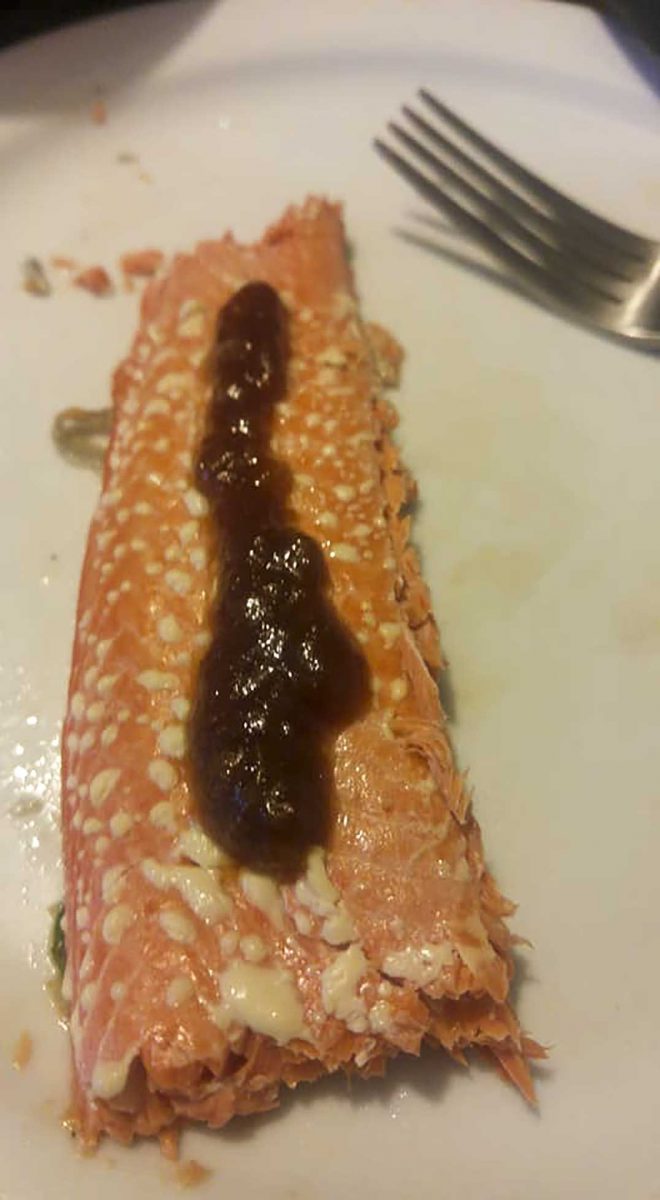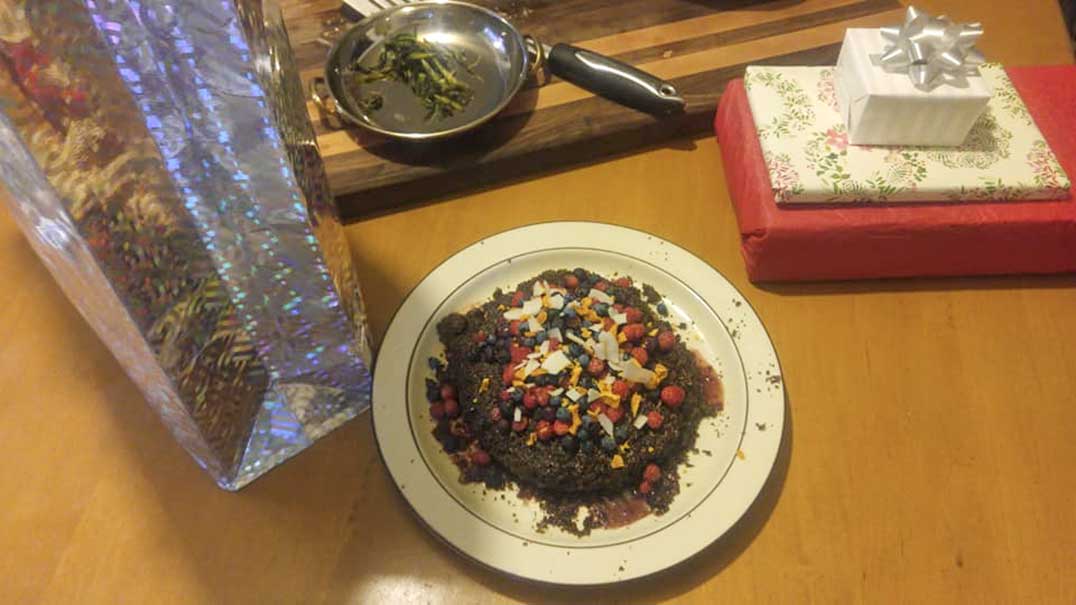Positive health results, a sturgeon encounter and burn-resistant skin
EDITOR’S NOTE: The Expositor will be checking in regularly with this couple who have ties to Manitoulin Island as they embark on their Big Wild Year challenge. This is the seventh update since they began.
NORTH BAY – A busy July during the Big Wild Year led to some positive health news and more travel adventures ahead of August, a month that is likely to take a bit of a slower pace due to a reduction in harvest potential.
“It was busy, but good if you love picking strawberries and blueberries and fishing trips,” said Delphanie Colyer. “August is kind of a slower month. There’s lots of berries to pick, seeds to pick and fishing. There’s not a lot of other greens and things in any great quantity that we’ll be collecting. The root plants won’t be ready until September.”
She and her partner Jeremy St. Onge are more than halfway through their Big Wild Year Challenge. For the entirety of 2019, the couple will only eat wild-foraged foods such as indigenous plants and animals they have hunted. Mr. St. Onge is an environmental studies professor at Canadore College and Ms. Colyer is a nurse with roots in Wiikwemkoong.
In the June update, their fishing and foraging productivity was sky-high and they were well on their way to their targeted harvest amounts. They also travelled to a foragers’ gathering in Michigan to serve as keynote speakers. This month, their travels took them northeast to the Cree community of Nemaska, Que., which is located as far north as James Bay.
“We drove 13 hours and the last bit of that drive is all gravel. Over 300 kilometres on gravel. We made it 100 kilometres in and got a flat tire so we had to drive the rest of the way on a doughnut. That didn’t speed the trip up any,” said Ms. Colyer with a laugh.
A former student of Mr. St. Onge’s who is friends with the couple is Cree. His community hosts an annual gathering for elders to pass their knowledge to the next generation. The couple were invited to attend and it offered them the chance to try out unique foods.

“We saw them smoking sturgeon and were super stoked. We were going to have some that had been prepped already, but then our friend’s son’s dog ate the fish!” said Ms. Colyer.
They did, however, get up close with a recently-caught individual.
“It was my first time seeing (a sturgeon). They’re really fascinating. I took some of the scales off its back,” said Ms. Colyer. “They’re like a dinosaur. They haven’t changed in millions of years and I’m trying to make jewelry out of the scales.”
They learned how to string up a goose over a fire so it cooks evenly and collects the fat that leaks out. The two caught their limit of walleye and checked out some five-hundred-year-old rock markings.
“It was kind of emotional for me. I’ve got such a desire to get back to my own community, my own teachings. Over the last few years I’ve been so busy that I feel a bit disconnected and like I’m in a race to get back to it,” said Ms. Colyer, adding that there was a good deal of overlap between the Ojibwe and Cree languages.
On their way home from the gathering, they came across a roadkill moose calf and managed to salvage the front quarter of the animal.
“It’s interesting how much roadkill we’ve eaten. To date we’ve had two roadkill deer, the bear cub, a turkey, a grouse, a mallard and now a moose. It’s good that we can pick it up when it’s around because it’s definitely been made use of,” said Ms. Colyer. The two have just found out that they were not granted any moose or elk tags for the upcoming hunting season, a disappointment for the two that were hoping to further bolster their sustenance stockpile.
Day 200 of the challenge coincided with the couple’s anniversary and sparked a cause for celebration.

“I happened to be picking up groceries for the kids at Metro down the street and saw salmon with a big sticker on it that said ‘wild caught.’ So I bought a chunk. Jeremy came over and I said, ‘I don’t know if you want to bend the rules but celebrating Day 200 like this would be pretty awesome.’ So we went for it. That was a real treat; I’ve missed salmon,” said Ms. Colyer.
On the health side of the challenge, all their test results across the board have either improved or maintained since the last checkup.
“Both of us dropped weight and body fat to a healthier level and we both maintained our grip strength,” said Mr. St. Onge. VO2 max (the maximum amount of oxygen the body can use during exercise) improved in Ms. Colyer and stayed the same in Mr. St. Onge. They also noticed their resting metabolic rate decreased, something Mr. St. Onge also found when reading about hunter-gatherers.
“When they’re out hunting and gathering, it’s a calorie balance so they’re burning off the exact same as they’re taking in. It might make you wonder how they stay healthy and maintain weight, but when they’re at rest they need way, way less (calories). I guess we’re kind of on our way to that,” said Ms. Colyer.
She noted that her body fat percentage is holding at 23.6, down from the starting point of 30. Mr. St. Onge’s body fat dropped from 25 percent to 16.8. Ms. Colyer said she expected her numbers to drop even further because she expects many more canoe trips to their hunting spot and walking a lot during grouse and deer hunting or foraging.
“We’ve had a lot of comments on social media about how we look way too thin or even anorexic,” said Mr. St. Onge.
“Our weight is in the ‘good’ range; we’re not even low enough to be considered ‘excellent,’ said Ms. Colyer.
“It’s interesting that people have such a negative image of what we’re doing but that’s only because they see so much of the opposite. Even think of our grandparents; there weren’t many big people until they got quite aged and sedentary. People stayed in much better shape,” she said. “And it’s not surprising, you see it all the time in what people get in a value meal when they go out to eat. Sizing has barely acknowledged the big shift in people’s weight.”
Further on the health spectrum, Mr. St. Onge’s nasal polyps have improved considerably, to the point where his doctor has considered recommending diet changes to his other patients to help manage the symptoms. There has also been one particularly peculiar spin-off effect from the challenge.
“I haven’t been able to get sunburns this summer. It’s really interesting because I burn really easily. I’ve only gotten one light burn this summer and it was gone when I woke up,” said Mr. St. Onge.
He said he normally keeps fairly covered under the sun but after picking blueberries for more than six hours he only had a faint hint of a sunburn on his arm. The two said they would be trying to do more research into the phenomenon to understand if it may be part of a bigger pattern.
To follow Ms. Colyer and Mr. St. Onge’s Big Wild Year, you can view their updates at Facebook.com/BigWildYear. The Expositor will be checking back with the two throughout the year to share their experiences in this unique endeavour.




